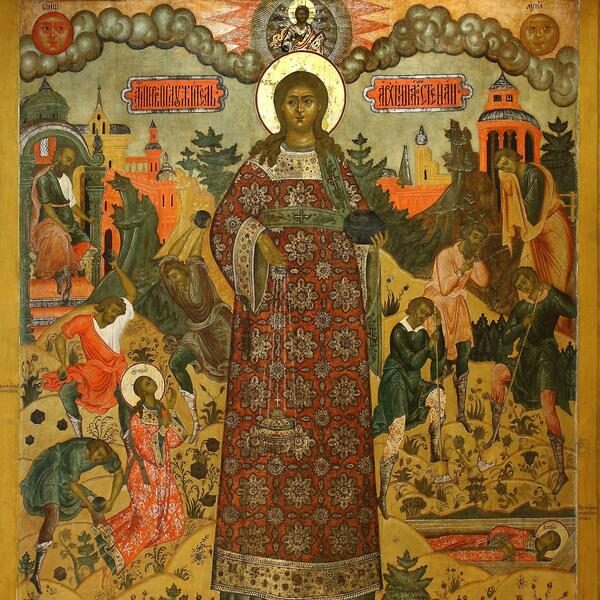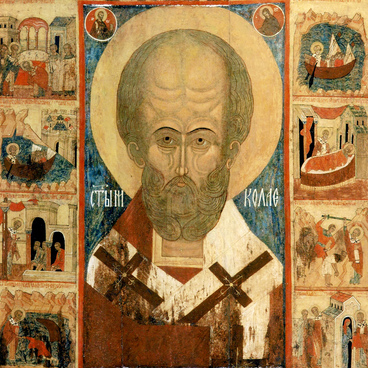Archdeacon Stephen suffered for his faith between the years 33 and 36 AD. He is traditionally venerated as the protomartyr of Christianity who was murdered for preaching the Word of God. His life is described in the Acts of the Apostles.
Stephen was one of the Hellenistic Jews who lived outside the Holy Land and spoke Greek (which is confirmed by his name of Greek origin meaning “wreath”). He was one of the seventy disciples chosen by Jesus and sent “two and two before his face into every city and place, whither he himself would come” (Luke 10:1). When Hellenistic Jews became dissatisfied because of being neglected in the “daily ministration” (Acts 6:1), seven believers were appointed deacons to keep order. Stephen was the eldest of them and was elected the archdeacon. Saint Stephen was known in Jerusalem for his preaching, wonders, and miracles.
His speech to the Sanhedrin where he mentioned that “the most High dwelleth not in temples made with hands” (Acts 7:48) infuriated the members of the assembly, and Stephen was convicted. In his speech, the longest one in Acts of the Apostles, Stephen told of the history of Israel and accused the judges of killing Jesus, or the Righteous One as he was called by Jerusalem Christians. At the end of his speech, Stephen saw the heaven open above him and the Son of Man sitting to the right of God. After all of this, the crowd could contain their anger no longer. They dragged Stephen outside the city and stoned him to death.
He was executed immediately, without delivering judgment or having it approved by the Roman authorities which seems unlawful. This is why it should be considered not as lapidation, or execution by stoning, but a murder committed by a furious crowd.
The martyr prayed to Jesus asking him to receive his spirit and forgive his killers and died.
In the icons, Stephen is depicted as a beardless young man (presumably, he was around 30 years old at the time of death). He is wearing a sticharion — a long robe with wide sleeves. The red color indicates his death as a martyr. His garment and the censer in the right hand indicate that even after death he continues his service in heaven. In the left hand, he carries a stone which refers to the weapon with which he was murdered. In other icons, stones are also often depicted on his head and shoulders. In this case, the saint holds a palm frond as a symbol of triumph over death.
In this icon, there are two additional scenes to the sides of Stephen’s figure. The left one depicts the scene of his death witnessed by the heathen Saul (later known as Paul the Apostle), and the right one — the burial of Stephen with another figure lamenting his death.
Stephen was one of the Hellenistic Jews who lived outside the Holy Land and spoke Greek (which is confirmed by his name of Greek origin meaning “wreath”). He was one of the seventy disciples chosen by Jesus and sent “two and two before his face into every city and place, whither he himself would come” (Luke 10:1). When Hellenistic Jews became dissatisfied because of being neglected in the “daily ministration” (Acts 6:1), seven believers were appointed deacons to keep order. Stephen was the eldest of them and was elected the archdeacon. Saint Stephen was known in Jerusalem for his preaching, wonders, and miracles.
His speech to the Sanhedrin where he mentioned that “the most High dwelleth not in temples made with hands” (Acts 7:48) infuriated the members of the assembly, and Stephen was convicted. In his speech, the longest one in Acts of the Apostles, Stephen told of the history of Israel and accused the judges of killing Jesus, or the Righteous One as he was called by Jerusalem Christians. At the end of his speech, Stephen saw the heaven open above him and the Son of Man sitting to the right of God. After all of this, the crowd could contain their anger no longer. They dragged Stephen outside the city and stoned him to death.
He was executed immediately, without delivering judgment or having it approved by the Roman authorities which seems unlawful. This is why it should be considered not as lapidation, or execution by stoning, but a murder committed by a furious crowd.
The martyr prayed to Jesus asking him to receive his spirit and forgive his killers and died.
In the icons, Stephen is depicted as a beardless young man (presumably, he was around 30 years old at the time of death). He is wearing a sticharion — a long robe with wide sleeves. The red color indicates his death as a martyr. His garment and the censer in the right hand indicate that even after death he continues his service in heaven. In the left hand, he carries a stone which refers to the weapon with which he was murdered. In other icons, stones are also often depicted on his head and shoulders. In this case, the saint holds a palm frond as a symbol of triumph over death.
In this icon, there are two additional scenes to the sides of Stephen’s figure. The left one depicts the scene of his death witnessed by the heathen Saul (later known as Paul the Apostle), and the right one — the burial of Stephen with another figure lamenting his death.



